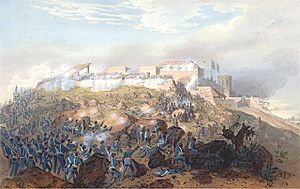Military history of the United States facts for kids
Quick facts for kids Military History of the United States |
|
|---|---|
| Established | |
| Parts | |
| Headquarters | The Pentagon, Arlington County, Virginia, U.S. |
| See also | |
| History |
List
American Revolutionary War
Whiskey Rebellion Indian Wars Barbary Wars War of 1812 Patriot War Mexican–American War Utah War Cortina Troubles Reform War American Civil War Las Cuevas War Spanish–American War Banana Wars Philippine–American War Boxer Rebellion Border War World War I Russian Civil War World War II Cold War Puerto Rican Nationalist Revolts Korean War 1958 Lebanon crisis Operation Power Pack Vietnam War Korean DMZ Conflict Operation Eagle Claw Multinational Force Lebanon Invasion of Grenada Operation Golden Pheasant Invasion of Panama Persian Gulf War Somali Civil War Kosovo War War on Terror
Iraq War |
The military history of the United States covers more than 200 years. During this time, the U.S. grew from a new country fighting for its freedom to a global superpower. This journey included the American Revolutionary War (1775–1783), the American Civil War (1861–1865), and working with allies in World War II (1941–1945).
In 1775, the Continental Congress created the Continental Army, Continental Navy, and Continental Marines. They chose General George Washington to lead them. This new military, helped by French soldiers and sailors, won against the British. This led to U.S. independence through the Treaty of Paris. In 1789, the new Constitution made the president the commander-in-chief. It also gave Congress the power to collect taxes, make laws, and declare war.
Today, the United States Armed Forces include the Army, Marine Corps, Navy, Air Force, and Space Force. All these branches are part of the Department of Defense. The Coast Guard is part of the Department of Homeland Security.
The President of the United States is the top leader, or commander-in-chief. The president uses this power through the Secretary of Defense and the Chairman of the Joint Chiefs of Staff. These leaders oversee military operations. State governors also control their state's Army and Air National Guard units for certain tasks. The president can also take control of National Guard units, placing them under the Department of Defense.
Contents
- Early Conflicts in America (1620–1774)
- Winning Independence (1775–1783)
- Early Years of the Nation (1783–1812)
- War of 1812
- War with Mexico (1846–1848)
- American Civil War (1861–1865)
- After the Civil War (1865–1917)
- Modernizing the Military
- Banana Wars (1898–1935)
- Moro Rebellion (1899–1913)
- Mexico (1910–1919)
- World War I (1914–1918)
- Russian Civil War (1918–1925)
- 1920s: Naval Disarmament
- 1930s: Neutrality Acts
- World War II (1941–1945)
- Cold War Era (1945–1991)
- After the Cold War (1990–2001)
- War on Terror (2001–Present)
Early Conflicts in America (1620–1774)
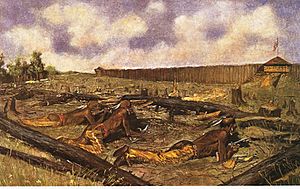
The U.S. military began with everyday settlers. These people were armed for hunting and to survive in the wild. They formed local groups called militias for small fights. These fights were mostly against Native American tribes. They also fought against possible attacks from nearby European colonies. For bigger military actions, they relied on the British regular Army and Navy.
In the early days of British colonization, military actions in the thirteen colonies often involved conflicts with Native Americans. Examples include the Pequot War in 1637 and King Philip's War in 1675.
Starting in 1689, the colonies joined in a series of wars between Great Britain and France. These wars were fought for control of North America. Important wars included Queen Anne's War, where the British took over the French colony of Acadia. The final French and Indian War (1754–63) saw Britain win against all French colonies in North America. This last war gave many colonists, like Virginia colonel George Washington, military experience. They used this experience during the American Revolutionary War.
War of Jenkins' Ear (1739–1748)
A conflict between Great Britain and Spain, known as the "War of Jenkins' Ear," began in 1739. It involved British colonists in South Carolina and Georgia fighting against the Spanish in Florida. A British expedition to Cartagena, Colombia, included American colonists. This expedition failed badly due to disease and poor leadership. Only about 600 of over 3,000 Americans returned home.
Winning Independence (1775–1783)
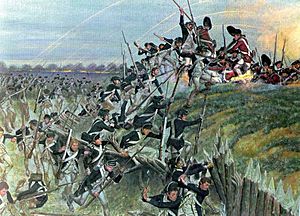
Growing tensions between Great Britain and the thirteen colonies became a crisis in 1774. The British put Massachusetts under military rule. This happened after colonists protested taxes they felt were unfair. When fighting began at Lexington and Concord in April 1775, local militias surrounded the British in Boston. The Continental Congress made George Washington the commander-in-chief of the new Continental Army. This army was supported by colonial militias. Congress also created the Continental Navy and Continental Marines. Washington forced the British out of Boston. However, in late 1776, the British returned to New York and almost captured Washington's army. Meanwhile, the colonists removed British officials and declared themselves an independent nation on July 4, 1776.
The British did not have a clear plan or unified command. The Royal Navy helped them capture coastal cities. But they could not control the countryside. A British attack from Canada in 1777 ended with a big loss at Saratoga. In 1777, General von Steuben helped train the Continental Army. This made it a more modern fighting force. France and Spain then joined the war against Great Britain. This ended Britain's naval advantage and made the conflict a world war. The Netherlands later joined France. The British were outnumbered on land and sea. They had few allies besides Native American tribes, Loyalists, and Hessian soldiers.
In 1779, the war shifted to the southern American states. The British won some battles there. But General Nathanael Greene used guerrilla warfare to stop their progress. The main British army was surrounded by Washington's American and French forces at Yorktown in 1781. The French fleet blocked any British rescue by sea. The British then asked for peace.
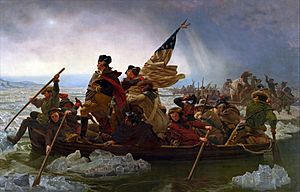
George Washington's Leadership
General George Washington (1732–1799) was a great leader and organizer. He worked well with Congress and state governors. He chose his officers carefully and trained his troops. His biggest challenge was getting supplies. Congress and the states did not have enough money for equipment, weapons, clothing, or even food for the soldiers. On the battlefield, Washington was sometimes outsmarted by the British. But as a strategist, he knew how to win the war better than they did. Washington's plan forced the first British army out of Boston in 1776. He was also responsible for the surrender of two other British armies at Saratoga (1777) and Yorktown (1781). He kept Patriot control over most of the population. The Loyalists, who supported the British, were about 20% of the population but were not well organized. After the war, Washington retired to his farm. He surprised the world by not trying to seize power. This set a tradition of civilian control over the U.S. military.
Early Years of the Nation (1783–1812)
After the American Revolutionary War, the U.S. faced military issues at sea and on the western frontier. The U.S. was a small military power then. It had only a modest army, marine corps, and navy. People did not trust large standing armies. They believed in local militias. This stopped the growth of well-trained units and professional officers. Leaders like Thomas Jefferson preferred a small military. They feared a large military would lead to too many foreign wars or a powerful ruler at home.
In the Treaty of Paris, Britain gave lands between the Appalachian Mountains and the Mississippi River to the U.S. This was done without asking the Shawnee, Cherokee, Choctaw, and other tribes living there. Many tribes had fought with the British. So, the U.S. made tribal leaders sign away lands in treaties. They then began to divide these lands for settlers. This led to a war in the Northwest Territory. U.S. forces did not do well at first. The Battle of the Wabash in 1791 was a big loss for the U.S. against Native Americans. President Washington sent a newly trained army led by General Anthony Wayne. This army defeated the Indian alliance at the Battle of Fallen Timbers in 1794.
When revolutionary France declared war on Great Britain in 1793, the U.S. wanted to stay neutral. But the Jay Treaty, which favored Britain, angered France. French ships began to seize U.S. vessels. This led to an undeclared "Quasi-War" between the two nations from 1798 to 1800. The U.S. won several battles in the Caribbean. George Washington was asked to lead a "provisional army" in case France invaded. But President John Adams negotiated a truce. France agreed to end the old alliance and stop its attacks.
Barbary Wars
Berbers along the Barbary Coast (modern-day Libya) used pirates to capture merchant ships. They held crews for ransom. The U.S. paid protection money until 1801. Then, President Thomas Jefferson refused to pay and sent the Navy to challenge the Barbary States. This started the First Barbary War. In 1803, the USS Philadelphia was captured. Lieutenant Stephen Decatur led a raid to burn the ship. This stopped Tripoli from using or selling it. In 1805, after William Eaton captured Derna, Tripoli agreed to a peace treaty. Other Barbary states kept raiding U.S. shipping until the Second Barbary War in 1815 ended the practice.
War of 1812
The War of 1812 was the biggest military action for the U.S. during this time. Britain was fighting a major war with Napoleonic France. Its policy was to stop American shipments to France. The U.S. wanted to stay neutral and trade overseas. Britain stopped this trade and forced American sailors into the Royal Navy. Britain also supported a Native American uprising in the American Midwest. Their goal was to create an Indian barrier state to block American expansion. The U.S. finally declared war on the United Kingdom in 1812. This was the first time the U.S. officially declared war.
The U.S. attacked British Canada. They hoped to use captured land as a bargaining chip. The invasion of Canada failed. However, wars with Native Americans on the western front (Tecumseh's War and the Creek War) were more successful. After defeating Napoleon in 1814, Britain sent large armies to invade New York, raid Washington, and capture New Orleans. The New York invasion failed. The British burned Washington on August 25, 1814. But they were stopped at the Battle of Baltimore. The major invasion in Louisiana was stopped at the Battle of New Orleans. This battle killed three top British generals and thousands of soldiers. Major General Andrew Jackson, who later became president, led the Americans to victory. The peace treaty was successful, and the U.S. and Britain never fought again. The Native Americans lost, as they never got the independent territory Britain promised.
War with Mexico (1846–1848)
As the farming population grew, many Americans looked west for new lands. This idea was called "Manifest Destiny." In the Texas Revolution (1835–1836), settlers declared independence as the Republic of Texas. They defeated the Mexican Army. But Mexico wanted to take back the lost land. Mexico threatened war if the U.S. annexed Texas. The U.S. was much larger and stronger. It annexed Texas in 1845. War broke out in 1846 over border issues.
In the Mexican–American War (1846–1848), the U.S. Army invaded Mexico. Generals Zachary Taylor and Winfield Scott led the forces. After many victories, they took Santa Fe de Nuevo México and Alta California. They also blocked the coast, invaded northern Mexico, and captured Mexico City. The peace terms involved the U.S. buying the area from California to New Mexico for $10 million.
American Civil War (1861–1865)
Long-standing tensions between the Northern and Southern States over slavery reached a peak. This happened after Abraham Lincoln was elected president in 1860. Lincoln was from the new anti-slavery Republican Party. Southern states then left the U.S. and formed the Confederacy. Many U.S. forts in the Confederate states still had troops loyal to the Union. Fighting began in 1861 when Confederate troops fired on Fort Sumter. This sparked strong feelings of patriotism in both the North and the South.
Both sides had weak military forces at the start of the Civil War. Neither the North's small army nor the South's state militias were ready for a civil war. Both sides quickly tried to raise new armies. These armies were larger than any U.S. forces before. They first asked for volunteers. Later, they used unpopular large-scale conscription (drafting soldiers) for the first time in U.S. history.
The Union Army first tried to win quickly by capturing the Confederate capital at Richmond, Virginia. This city was not far from the U.S. capital in Washington, D.C.. The Confederate States Army hoped to win by getting Britain and France to help them. Or they hoped to make the North tired of fighting.
As fighting around the capitals slowed, the North had more success elsewhere. They used rivers, railroads, and the seas to move and supply their larger forces. This helped them blockade the South, a plan called the Anaconda Plan. The war spread across the continent and even to the seas. After four years of very bloody conflict, the North's larger population and factories slowly wore down the South. The South's resources and economy were ruined. The North's factories and economy grew by filling government wartime orders.
The American Civil War is sometimes called the "first modern war." This is because it involved using all of a nation's resources, including civilians, for the war effort (total war). It also saw many new military inventions. These included railroads, telegraphs, rifles, trench warfare, and ironclad warships with turret guns.
After the Civil War (1865–1917)
Indian Wars (1865–1891)
After the Civil War, more people moved west. Railroads were built, and buffalo herds were hunted. This increased tensions on the Great Plains. Many tribes, especially the Sioux and Comanche, strongly resisted being moved to reservations. The Army's main job was to keep Native Americans on reservations. They also worked to end conflicts between tribes and with settlers. Generals William Tecumseh Sherman and Philip Sheridan were in charge. A famous victory for the Plains Nations was the Battle of the Little Bighorn in 1876. In this battle, Col. George Armstrong Custer and over 200 members of the 7th Cavalry were killed. They were defeated by Native Americans from the Lakota, Northern Cheyenne, and Arapaho nations. The last major conflict ended in 1891 with the Wounded Knee Massacre.
Spanish–American War (1898)
The Spanish–American War was short but decisive. America won quickly at sea and on land against the Spanish Empire. The Navy was ready and performed well. The Army also fought well in Cuba. However, it was not as ready for an overseas conflict. It relied on volunteers and state militias. These groups faced problems with supplies, training, and food in Florida. The U.S. freed Cuba (after a U.S. Army occupation). By the peace treaty, Spain gave Puerto Rico, Guam, and the Philippines to the United States. The Navy set up coaling stations there and in Hawaii. Hawaii had been taken over in 1893 and annexed in 1898. The U.S. Navy now had a strong presence across the Pacific Ocean. It also had a major base in the Caribbean, guarding the approaches to the Gulf Coast and the Panama Canal.
Philippine–American War (1899–1902)
The Philippine–American War (1899–1902) was a conflict between Filipino revolutionaries and American forces. This happened after Spain gave the Philippines to the U.S. The Army sent 100,000 soldiers, mostly from the National Guard. General Elwell Otis led them. The rebels were defeated in battle and lost their capital in March 1899. They then broke into smaller armed groups. The rebellion ended in March 1901 when their leader, Emilio Aguinaldo, was captured. American forces lost 1,037 killed in action and 3,340 died from disease. About 20,000 rebels were killed. The war also caused at least 200,000 Filipino civilian deaths, mostly from famine and disease. Some estimates say up to a million civilians died. The U.S. committed harsh acts during the conflict. These included revenge attacks, burning land, and forcing civilians to move.
Overthrow of Hawaii (1893)
The Hawaiian Kingdom was overthrown on January 16, 1893. This was a coup d'état (a sudden, illegal takeover of government) against Queen Liliʻuokalani. Before this, the 1887 Constitution of the Hawaiian Kingdom had already weakened the Hawaiian monarchy. This "Bayonet Constitution" was created by pro-American residents. It aimed to give power to non-Native settlers. It was called the Bayonet Constitution because armed groups forced King Kalākaua to sign it.
The coup was led by the Committee of Safety. This group of 13 non-Native Hawaiians organized armed men to remove Queen Liliʻuokalani. The U.S. military helped in the coup. They sent the USS Boston cruiser and 162 U.S. Navy and Marine Corps personnel. They said this was to protect American lives, property, and business interests, especially sugar plantations. The Queen was put under house arrest until her death in 1917. The goal was to make Hawaii part of the United States. The rebels formed the Republic of Hawai'i, with Sanford B. Dole as its first president. Hawaii was annexed by the U.S. in 1898. The U.S. military still has a large presence in Hawaii. They have been linked to environmental damage and pollution there.
Modernizing the Military
The Navy was updated in the 1880s. By the 1890s, it adopted Captain Alfred Thayer Mahan's naval power strategy. Old sailing ships were replaced by modern steel battleships. In 1907, most of the Navy's battleships, called the Great White Fleet, sailed around the world for 14 months. President Theodore Roosevelt ordered this mission. It showed the Navy's ability to operate globally.
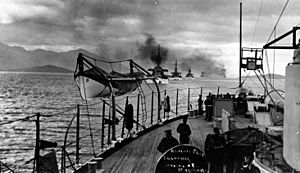
Secretary of War Elihu Root (1899–1904) modernized the Army. He wanted a chief of staff and a general staff for planning. He succeeded in making West Point larger. He also started the United States Army War College and the General Staff. Root changed promotion rules and created schools for different military branches. He also made sure officers rotated between staff and field duties.
Rear Admiral Bradley A. Fiske was a leader in new naval gun technology from 1890–1910. He saw the potential of air power and called for a torpedo plane. Fiske also suggested a major reorganization of the Navy. He wanted to centralize power in a chief of naval operations. This leader and an expert staff would create new strategies. They would also oversee fleet building, war planning, and ensure the Navy had the best war machines. The Navy adopted his ideas and began to reorganize by 1915 for possible involvement in World War I.
Banana Wars (1898–1935)
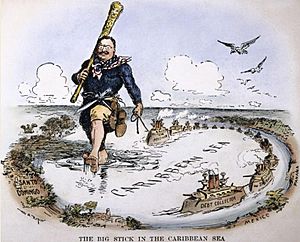
The Banana Wars is a term for smaller U.S. military actions in Latin America from 1898 to 1935. These included military presence in Cuba, Panama (with the Panama Canal Zone), Haiti (1915–1935), Dominican Republic (1916–1924), and Nicaragua (1912–1925; 1926–1933). The U.S. Marine Corps became experts in long-term military occupation of these countries. Their main goal was to protect customs revenues, which often caused local civil wars. For example, in May 1912, President William H. Taft sent 1,292 Marines to Cuba. They protected American-owned sugarcane plantations, copper mines, and railroads during the Negro Rebellion. Between 3,000 and 6,000 Afro-Cubans, including civilians, were killed by the Cuban Army.
Hispaniola Interventions
Rebellion and guerrilla fighting were common during these occupations. In the Dominican Republic (1916–1922), U.S. Marines lost 17 killed and 55 wounded. They caused about 1,000 Dominican casualties. The most serious rebellions were in Haiti. About 5,000 mountain people called Cacos rebelled in 1915–17. They lost 200 killed, while Marines lost 3 killed. In 1918, the Cacos rebelled again. They were angry about forced labor. This rebellion lasted over 19 months. Both Caco leaders were killed, along with at least 2,004 of their men. The Marines lost 28 killed.
Moro Rebellion (1899–1913)
The Moro Rebellion was an armed conflict between Muslim Filipino tribes in the southern Philippines. It lasted from 1899 to 1913. Even after this, small anti-government rebellions continued into the 21st century. American advisors still help Philippine government forces.
Mexico (1910–1919)
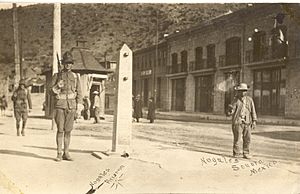
The Mexican Revolution involved many coups (takeovers) of the government. President Woodrow Wilson did not approve of this. He sent U.S. forces to occupy the Mexican city of Veracruz for six months in 1914. This happened after American sailors were arrested in the "Tampico Affair". In early 1916, Mexican general Pancho Villa led a raid on the American city of Columbus, New Mexico. Wilson sent the U.S. Army under General John J. Pershing to pursue Villa. Villa fled deep into Mexico. Mexican nationalism turned against the U.S. With war with Germany looming, Wilson ordered Pershing to withdraw. Villa escaped.
World War I (1914–1918)

The United States wanted to stay neutral when World War I started in August 1914. However, it insisted on its right to be safe from German submarine attacks. This was true even if its ships carried food and raw materials to Britain. In 1917, the Germans started submarine attacks again. They knew this would make America join the war. When the U.S. declared war in April 1917, the Army was small. It would take at least a year to get ready. Meanwhile, the U.S. sent supplies and money to Britain and France. It also started the first peacetime draft.
By summer 1918, a million American soldiers, called "doughboys," were in Europe. They served on the Western Front under General John J. Pershing. Another 10,000 arrived every day. The German Army's Spring Offensive failed. This used up their soldiers, and they could not attack again. The Imperial German Navy and people at home revolted. A new German government signed a conditional surrender, called the Armistice, on November 11, 1918. This ended the war on the Western Front.
Russian Civil War (1918–1925)
The "Polar Bear Expedition" involved 5,000 U.S. troops. They were part of a larger Allied military effort to stop the Bolsheviks in Arkhangelsk, Russia. There was no major fighting for the Americans.
The U.S. hosted a big world conference to limit naval weapons. This included the U.S., Britain, Japan, and France. Secretary of State Charles Evans Hughes proposed that each country reduce its warships. This plan was accepted. The conference helped major powers reduce their navies and avoid conflict in the Pacific. The treaties lasted for ten years. But they were not renewed as tensions grew.
1930s: Neutrality Acts
After the costly World War I, many Americans wanted to stay out of foreign conflicts. This idea is called isolationism. Congress refused to join the League of Nations. This was mainly because of Article X of the League's rules. This rule would have required the U.S. Military to intervene if a League member was attacked. This made the Senate strongly oppose the Treaty of Versailles. Isolationism grew even more after the Nye Committee investigated military spending. This fueled the "Merchants of death" idea, increasing anti-war feelings.
To avoid getting involved in wars, the U.S. passed the Neutrality Acts. These laws aimed to stop the U.S. from helping either side in a war. President Franklin D. Roosevelt wanted to support Britain. In 1940, he signed the Lend-Lease Act. This allowed the U.S. to expand "cash and carry" arms trade with Britain. Britain controlled the Atlantic sea lanes.
Roosevelt favored the Navy. He used programs like the Public Works Administration to support Navy yards and build warships. For example, in 1933, he approved $238 million for 32 new ships. The Army Air Corps received much less money.
The U.S. was slow to get involved in overseas conflicts due to public and political pressure. The U.S. only offered non-recognition for the Japanese invasion of Manchuria in 1931. Events like Benito Mussolini's Italian Conquest of Ethiopia were also ignored. No official involvement happened during the Spanish Civil War or the Second Sino-Japanese War. However, loopholes allowed some U.S. involvement, like volunteering or using British ships to deliver supplies. This, along with Roosevelt's Quarantine Speech, caused mixed opinions. Non-interventionists were mostly Republicans. But some Democrats also tried to pass bills to require a public vote before military involvement. This "amendment" failed to get enough support.
The lack of military involvement led to appeasement (giving in to demands) in the early stages of World War II. Roosevelt wanted to continue cash-and-carry for Europe and the Pacific. After Germany's invasion of Poland, Roosevelt finally got Congress to restore arms trade with warring nations. Many say this helped the U.S. economy. Full involvement in the war began after the Attack on Pearl Harbor. This event caused isolationism to fade.
World War II (1941–1945)
Starting in 1940, the U.S. prepared for war, focusing on air power. Before Pearl Harbor, the U.S. sent war materials and money to Britain, the Soviet Union, and China. The U.S. officially entered on December 8, 1941, after the Japanese attack on Pearl Harbor, Hawaii. Japanese forces quickly took American, British, and Dutch lands across the Pacific and Southeast Asia. Hawaii and Australia became key bases for taking back these areas.
The loss of eight battleships and 2,403 Americans at Pearl Harbor forced the U.S. to rely on its remaining aircraft carriers. These carriers won a big victory over Japan at Midway just six months into the war. The U.S. also relied on its growing submarine fleet. The Navy and Marine Corps then used an island hopping strategy across the Pacific from 1943–1945. They reached the edge of Japan in the Battle of Okinawa. In 1942 and 1943, the U.S. sent millions of men and thousands of planes and tanks to the UK. This began with strategic bombing of Nazi Germany and occupied Europe. It led to the Allied invasions of North Africa (1942), Sicily and Italy (1943), France (1944), and the invasion of Germany (1945). This happened at the same time as the Soviet invasion from the Eastern Front. Nazi Germany surrendered in May 1945. Fighting in Central Europe was especially bloody for the U.S. More U.S. military deaths happened in Germany than in any other country during the war.
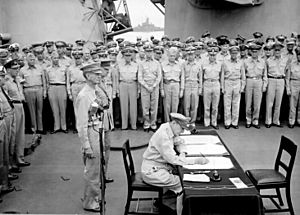
In the Pacific, the U.S. had many naval successes in 1944. But bloody battles at Iwo Jima and Okinawa in 1945 made the U.S. look for a way to end the war with fewer American lives lost. The U.S. used atomic bombs on Hiroshima and Nagasaki. This destroyed Japan's war effort and shocked its leaders. Japan quickly surrendered. After the atomic bombs, Japan surrendered to the Allied forces on August 15, 1945. This ended 35 years of Japanese rule in Korea. American forces arrived in the southern part of Korea on September 8, 1945. The Soviet Army and some Korean Communists were in the northern part.
The U.S. quickly mobilized and became a dominant military power. The industrial strength of the U.S. economy was a major factor in the Allies' success. Lessons learned, like the importance of air superiority and aircraft carriers, still guide U.S. military strategy today.
World War II is seen as America's greatest triumph. U.S. military personnel from this war are called "the Greatest Generation." Over 16 million Americans served, and over 400,000 died. The U.S. emerged as one of two main superpowers, along with the Soviet Union. Unlike the Soviet Union, the U.S. homeland was mostly untouched by the war. During and after World War II, the U.S. and Britain developed a strong defense and intelligence partnership. This includes U.S. bases in the UK, shared intelligence, and shared military technology.
Cold War Era (1945–1991)
After World War II, the United States became a global superpower. It faced the Soviet Union in the Cold War. During this time, the U.S. gave military aid and got involved in proxy wars against the Soviet Union. It was a main player in the Korean War and Vietnam War. The U.S. and Soviet Union kept nuclear weapons ready, based on the idea of mutually assured destruction. This meant both sides would be destroyed if they attacked each other.
Postwar Military Changes (1947)
The National Security Act of 1947 reorganized the military. It combined the Department of the Navy and War Department into a single cabinet-level Department of Defense. The act also created the National Security Council, the Central Intelligence Agency, and the Air Force.
Korean War (1950–1953)
The Korean War was a conflict between the U.S. and its United Nations allies, and the communist powers. The main fighters were North and South Korea. South Korea's allies included the U.S., Canada, Australia, and the United Kingdom. Many other nations sent troops under the United Nations Command. North Korea's allies included People's Republic of China, which sent soldiers, and the Soviet Union, which sent advisors and aircraft.
The war started badly for the U.S. and UN. The Korean People's Army attacked in summer 1950. They almost pushed the U.S. and South Korean defenders into the sea. But the United Nations stepped in. They named Douglas MacArthur commander. UN-U.S.-South Korean forces held a small area around Pusan. This gave them time for more troops to arrive. MacArthur ordered a risky amphibious invasion behind enemy lines at Inchon. This cut off and defeated the North Koreans. UN forces quickly crossed the 38th Parallel into North Korea.
As UN forces moved toward the Yalu River on the border with China, the Chinese crossed the river in October. They launched surprise attacks. This pushed UN forces back across the 38th Parallel. President Truman first wanted to unite Korea. After China's success, he aimed to contain communism and split the country. MacArthur wanted to push back, but President Harry Truman fired him after disagreements. Peace talks lasted two years. President Dwight D. Eisenhower threatened China with nuclear weapons. An armistice was quickly reached. The two Koreas remained divided at the 38th parallel. North and South Korea are still technically at war, as they never signed a peace treaty. American forces remain in South Korea.
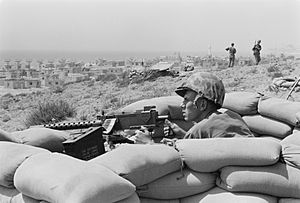
Lebanon Crisis of 1958
In the 1958 Lebanon crisis, civil war threatened. Operation Blue Bat sent several hundred Marines to support the pro-Western Lebanese government. This lasted from July 15 to October 25, 1958.
Dominican Intervention (1965)
On April 28, 1965, 400 Marines landed in Santo Domingo. They were there to evacuate the American Embassy and foreign citizens. This happened after Dominican forces tried to overthrow the government. By mid-May, 23,850 U.S. soldiers, Marines, and Airmen were in the Dominican Republic. They evacuated nearly 6,500 people from 46 nations. They also gave out over 8 million tons of food. The U.S. lost 27 killed and 172 wounded.
Vietnam War (1964–1975)
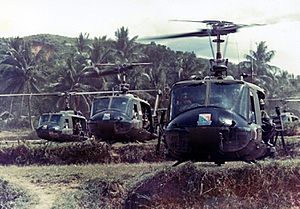
The Vietnam War was fought from 1955 to 1975 in South Vietnam and nearby areas of Cambodia and Laos. It also involved strategic bombing of North Vietnam. American advisors arrived in the late 1950s. They helped South Vietnam fight communist rebels called "Viet Cong." Major American military involvement began in 1964. This was after Congress gave President Lyndon B. Johnson approval to use force in the Gulf of Tonkin Resolution.
One side included South Vietnam, the U.S., South Korea, Thailand, Australia, New Zealand, and the Philippines. They fought against the North Vietnamese Army (NVA) and the National Liberation Front (NLF, or Viet Cong). The NVA received much military and economic aid from the Soviet Union and China. This made Vietnam a proxy war.
U.S. strategies changed over the years. Air Force bombing campaigns were controlled by the White House for political reasons. Until 1972, they avoided major Northern cities. They focused on bombing jungle supply trails, like the Ho Chi Minh Trail. General William Westmoreland aimed to defeat all enemy forces. But this led to many American casualties, which angered the public at home.
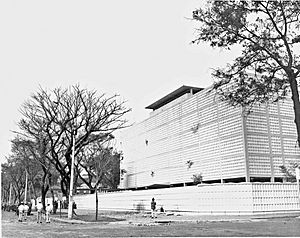
The U.S. saw the war as part of its policy to contain Communism in Southeast Asia. But American forces were frustrated. They could not fight decisive battles. There was also corruption in the Army of the Republic of Vietnam. Protests at home grew. The Tet Offensive in 1968 was a big military defeat for the NLF. But it was a psychological turning point in the war. In November 1969, the 1968 My Lai massacre was revealed. American soldiers killed 347 to 504 Vietnamese civilians. This further increased opposition to U.S. involvement.
President Richard M. Nixon wanted to achieve détente (less tension) with the Soviet Union and China. American policy shifted to "Vietnamization." This meant giving large amounts of weapons and letting the Vietnamese fight. After over 57,000 American deaths, U.S. forces left in 1973 without a clear victory. In 1975, South Vietnam was conquered by communist North Vietnam and unified.
Memories and lessons from the war still affect American politics. Some see the war as a necessary part of containing communism. Others see it as a "quagmire"—a waste of American lives and money. Fears of another quagmire have influenced foreign policy debates ever since. The draft became very unpopular. President Nixon ended it in 1973. This forced the military to rely on volunteers.
Between 966,000 and 3,010,000 Vietnamese people died during the war. This included 405,000 to 627,000 civilians. Also, the effects of Agent Orange and other chemicals used during Operation Ranch Hand still harm the environment. They also cause illness among Vietnamese people and their descendants. The soil in Vietnam still has many of these chemicals. These chemicals can cause many health problems, like cancers and birth defects.
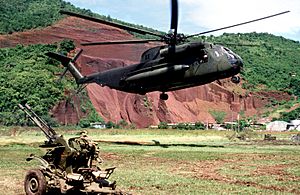
Grenada (1983)
In October 1983, a power struggle in Grenada led to increased tensions. Prime Minister Maurice Bishop was removed and executed. Neighboring nations asked the U.S. to intervene. The invasion, called Operation Urgent Fury, began on October 25. Over a thousand Americans quickly took the island. They fought Grenadian and Cuban soldiers. They captured hundreds of military and civilian prisoners, especially Cubans.
Beirut (1983)
In 1983, fighting between Palestinian refugees and Lebanese groups restarted the civil war. A UN agreement brought an international force of peacekeepers to Beirut. U.S. Marines landed in August 1982 with Italian and French forces. On October 23, 1983, a bomber drove a truck with 6 tons of TNT into the Marine barracks. It destroyed the barracks, killing 241 Marines. Seconds later, another bomber destroyed a French barracks, killing 58. The U.S. Navy then bombed militia positions in Lebanon. President Ronald Reagan eventually ordered the Marines to withdraw in February 1984 due to public pressure.
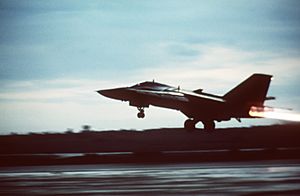
Libya (1986)
Operation El Dorado Canyon was a joint United States Air Force, Navy, and Marine Corps air strike against Libya on April 15, 1986. The attack was in response to the 1986 Berlin discotheque bombing. It resulted in the deaths of 45 officers and 15 civilians.
Panama (1989)
On December 20, 1989, the U.S. invaded Panama. This was mainly from U.S. bases in the Canal Zone. The goal was to remove dictator Manuel Noriega. American forces quickly defeated the Panamanian Defense Forces. Noriega was captured on January 3, 1990, and imprisoned in the U.S. A new government was put in place.
After the Cold War (1990–2001)
Persian Gulf War (1990–1991)
The Persian Gulf War was a conflict between Iraq and a coalition of 34 nations led by the U.S. The war began after Iraq invaded Kuwait in August 1990. The United Nations immediately placed economic penalties on Iraq. The coalition started fighting in January 1991. This led to a clear victory for the U.S.-led forces. They drove the Iraqi Armed Forces out of Kuwait with few coalition deaths. Despite the low death toll, over 180,000 U.S. veterans later became "permanently disabled" due to Gulf War syndrome. The main battles were air and ground combat in Iraq, Kuwait, and parts of Saudi Arabia.
Before the war, many thought the U.S. and its allies would win but suffer many casualties. They thought the tank battles in the desert might be like those in World War II. Iraqi forces were experienced after 8 years of war with Iran. They had modern Soviet tanks and jet fighters. But their anti-aircraft weapons were weak. The U.S. had not fought a large-scale war since Vietnam. Many changes in U.S. military strategy and technology had not been tested.
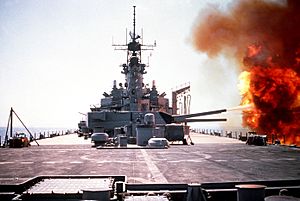
However, the battle was very one-sided from the start. U.S. technology was a key factor. But the quick collapse of Iraq was also due to poor leadership and low morale among Iraqi troops. After strong attacks on Iraqi air defenses and command centers on January 17, 1991, coalition forces quickly gained total control of the air. The Iraqi Air Force was destroyed in a few days. Some planes fled to Iran. The U.S.'s advanced technology, like stealth aircraft and infrared sights, made the air war easy. Any tank that started its engine became an easy target. Air defense radars were quickly destroyed by missiles. Videos from missile cameras showed a new kind of war, like a video game. After 6 weeks of constant bombing, the Iraqi Army was almost completely defeated. They did not retreat, following orders from Iraqi President Saddam Hussein. When ground forces invaded on February 24, many Iraqi troops quickly surrendered to much smaller forces.
After only 100 hours of ground fighting, U.S. President George H. W. Bush ordered a cease-fire. Negotiations began, leading to an agreement to stop fighting. Some U.S. politicians were disappointed. They thought Bush should have gone to Baghdad and removed Hussein from power. Coalition forces likely could have done this. But removing Hussein would have greatly expanded the conflict. Many coalition nations refused to join such an action. They believed it would create a power vacuum and destabilize the region.
After the Persian Gulf War, the U.S., Britain, and France created no-fly zones in northern and southern Iraq. This was to protect minority groups. The Iraqi military often tested these zones. The no-fly zones lasted until the 2003 invasion of Iraq. France stopped patrolling in 1996, saying the operation lacked a humanitarian purpose.
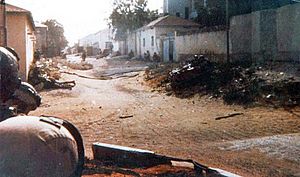
Somalia (1992–1993)
U.S. troops joined a UN peacekeeping mission in Somalia in 1992. By 1993, U.S. troops were joined by Rangers and special forces. Their goal was to capture warlord Mohamed Farrah Aidid. His forces had killed peacekeepers from Pakistan. During a raid in Mogadishu, U.S. troops were trapped overnight in the Battle of Mogadishu. Eighteen American soldiers were killed. Somali guerrillas suffered an estimated 1,000–5,000 casualties. After much public disapproval, President Bill Clinton quickly withdrew American forces. This event greatly affected U.S. ideas about peacekeeping. The book Black Hawk Down was written about the battle. It was later made into a movie.
Haiti (1994–1995)
Operation Uphold Democracy (September 19, 1994 – March 31, 1995) was an intervention to bring back elected President Jean-Bertrand Aristide. The United Nations Security Council Resolution 940 authorized this operation.
Yugoslavia (1990s)
During the Yugoslav Wars in the early 1990s, the U.S. operated in Bosnia and Herzegovina. This was part of the NATO-led multinational force (IFOR) in Operation Joint Endeavour. The U.S. was one of the NATO countries that bombed Yugoslavia between March 24 and June 9, 1999, during the Kosovo War. Later, it helped the multinational force KFOR.
War on Terror (2001–Present)
The War on Terrorism is a global effort by many countries, mainly the U.S. and its allies. Its goal is to stop international terrorist groups, especially Islamic extremist groups like al-Qaeda. It also aims to ensure that countries seen as "Rogue Nations" no longer support terrorism. This effort began mainly after the September 11, 2001 attacks on the United States. Since 2001, terrorists have attacked service members in Arkansas and Texas.
Afghanistan (2001–2021)
The intervention in Afghanistan (Operation Enduring Freedom – Afghanistan) was the first major campaign of the War on Terrorism. Its goals were to remove the Taliban government and destroy training camps linked to al-Qaeda. This war used Special Operations Forces heavily. It also involved political talks with local military groups and using proxy armies. This marked a big change from past U.S. military approaches.
On February 29, 2020, the U.S. and the Taliban signed a peace deal in Doha. This deal required U.S. troops to leave Afghanistan within 14 months. The Taliban had to promise not to let any groups, including Al Qaeda, use Afghanistan to threaten the U.S. and its allies. The Islamic Republic of Afghanistan was not part of this deal and rejected its terms about releasing prisoners. When Joe Biden became president, he moved the withdrawal date to August 31, 2021.
The withdrawal happened during the 2021 Taliban offensive. The U.S. carried out limited airstrikes to support Afghan forces and destroy captured equipment. The Taliban defeated the Afghan Armed Forces. This ended with the fall of Kabul on August 15, 2021. On that day, Afghanistan's president fled, and the Taliban declared victory. The U.S. military took control of Kabul's airport for Operation Allies Refuge. This operation evacuated citizens and certain Afghans.
Philippines (2002–Present)
In January 2002, the U.S. sent over 1,200 troops (later 2,000) to the Philippines. This was part of Operation Enduring Freedom – Philippines. Their goal was to help the Armed Forces of the Philippines fight terrorist groups linked to al-Qaida, like Abu Sayyaf. Most operations took place in the Sulu Archipelago, where terrorists are active. Most troops provide logistics (supplies and support). However, special forces troops train and assist in combat operations against terrorist groups.
Iraq War (2003–2011)
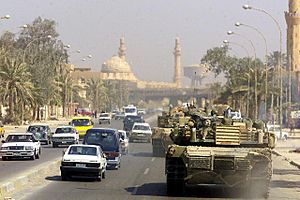
The Iraq disarmament crisis ended with the U.S. demanding that Iraqi President Saddam Hussein leave Iraq. He refused. A coalition led by the U.S. and the United Kingdom then fought the Iraqi army in the 2003 invasion of Iraq. About 250,000 U.S. troops, with support from British, Australian, and Polish forces, entered Iraq. They came mainly through their staging area in Kuwait. Coalition forces also supported Iraqi Kurdish militia. After about three weeks of fighting, Hussein and the Ba'ath Party were removed. This was followed by 9 years of military presence by the U.S. and the coalition. They fought alongside the new Iraqi government against various rebel groups.
Syrian and Iraqi Intervention (2014–Present)
When ISIL emerged and took large areas of Iraq and Syria, it caused international concern. ISIL committed killings and war crimes in both countries. Gains made in the Iraq War were lost as Iraqi army units abandoned their posts. Cities were taken over by ISIL, which enforced its strict laws. The kidnapping and execution of Western journalists and aid workers also caused outrage. The U.S. intervened with airstrikes in Iraq against ISIL in August 2014. In September, a coalition of U.S. and Middle Eastern powers began bombing in Syria. Their goal was to weaken and destroy ISIL and Al-Nusra-held territory. By December 2017, ISIL had no territory left in Iraq. They lost all remaining territory in Syria by March 2019. Airstrikes by U.S. and Coalition forces have continued in Syria against the Assad government, especially after the Douma chemical attack in 2018.
Libyan Intervention (2011)
During the First Libyan Civil War, the United Nations passed United Nations Security Council Resolution 1973. This created a no-fly zone over Libya. It also aimed to protect civilians from the forces of Muammar Gaddafi. The U.S., along with Britain, France, and other nations, formed a coalition against Gaddafi's forces. On March 19, 2011, the first U.S. action occurred. U.S. and UK warships launched 114 Tomahawk missiles. These destroyed Gaddafi's shoreline air defenses. The U.S. continued to play a major role in Operation Unified Protector. This was a NATO-led mission that included all military actions in the area. Throughout the conflict, the U.S. said it was only playing a supporting role. It claimed to be following the UN mandate to protect civilians. The real conflict was between Gaddafi loyalists and Libyan rebels trying to remove him. American drones were also used during the conflict.


